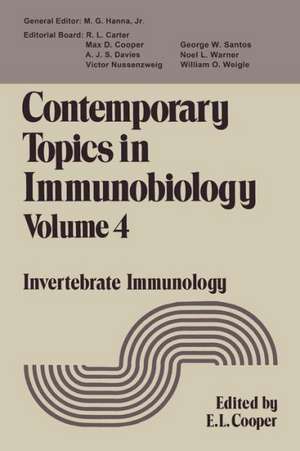Contemporary Topics in Immunobiology: Volume 4 Invertebrate Immunology: Contemporary topics in immunobiology, cartea 4
Editat de Edwin Cooperen Limba Engleză Paperback – 26 mar 2012
Preț: 369.29 lei
Preț vechi: 388.72 lei
-5% Nou
Puncte Express: 554
Preț estimativ în valută:
70.66€ • 73.78$ • 58.48£
70.66€ • 73.78$ • 58.48£
Carte tipărită la comandă
Livrare economică 04-18 aprilie
Preluare comenzi: 021 569.72.76
Specificații
ISBN-13: 9781468430509
ISBN-10: 1468430505
Pagini: 320
Ilustrații: XVIII, 300 p.
Dimensiuni: 152 x 229 x 17 mm
Greutate: 0.43 kg
Ediția:Softcover reprint of the original 1st ed. 1974
Editura: Springer Us
Colecția Springer
Seria Contemporary topics in immunobiology
Locul publicării:New York, NY, United States
ISBN-10: 1468430505
Pagini: 320
Ilustrații: XVIII, 300 p.
Dimensiuni: 152 x 229 x 17 mm
Greutate: 0.43 kg
Ediția:Softcover reprint of the original 1st ed. 1974
Editura: Springer Us
Colecția Springer
Seria Contemporary topics in immunobiology
Locul publicării:New York, NY, United States
Public țintă
ResearchCuprins
Introduction: General Comments and a Note on Taxonomy.- 1. Invertebrate Precursors to Immune Responses.- Self and Not-Self.- “Self-Recognition” in Colonial Marine Forms.- Sponges.- Colonial Ascidians.- General Aspects.- A Note on Self-Incompatibility in Plants.- Coelomate Invertebrates.- Hemagglutinins and Opsonins.- Hemocytes.- Analogies with Vertebrate Immune Responses.- References.- 2. An Electron Microscope Study of the Fate of Bacteria Phagocytized by Granulocytes of Crassostrea virginica.- The Present Problem.- Discussion and Conclusions.- Summary.- Acknowledgment.- References.- 3. On the Immediate Fate of Bacteria in the Land Snail Hel.- Clearance Mechanisms.- Discussion and Conclusions.- Acknowledgments.- References.- 4. Metabolism of Insect Hemocytes during Phagocytosis.- The Present Problem.- Human Phagocytosis.- Phagocytosis by Cockroach Hemocytes.- Summary of the Metabolic Events in Phagocytosis.- Acknowledgments.- References.- 5. The Coelomocytes of Nereid Polychaetes.- Fine Structure of Coelomocytes.- Discussion.- Conclusions.- Acknowledgments.- References.- 6. On the Ultrastructure of Invertebrate Hemocytes: An Interpretation of Their Role in Comparative Hematology.- The Blood.- Molluscan Hemocytes.- Annelid Hemocytes.- Sipunculid Hemocytes.- Arthropod Hemocytes.- Hemocytes of Echinoderms and Urochordates.- Conclusions.- References.- 7. The Octopus White Body: An Ultrastructural Survey.- The Leukopoietic Organs of Cephalopods.- Hemocytoblasts.- Hemocytoblasts to Leukoblasts.- Leukoblasts.- Secondary Leukoblasts to Mature Leukocytes.- Final Comment.- References.- 8. Earthworm Coelomocyte Immunity.- Historical Observations.- The Present Problem.- The Coelomocytes.- Coelomic Cavity.- Phagocytosis.- Interrelationships of Coelomocytes.- Coelomic CellResponses to Tissue Grafts.- Evolution of Delayed Hypersensitivity and the Anamnestic Response.- Final Comment.- References.- 9. An Approach to Studying Evolution of Cellular Immunity.- Cellular Immunity in an Invertebrate.- Activity of5 1 Cr Labeled Earthworm Coelomocytes.- Behavior of Labeled Normal Coelomocytes in Normal Hosts.- Behavior of Labeled Normal Coelomocytes in Wounded Hosts.- Behavior of Normal and Sensitized Coelomocytes in Grafted Hosts.- Summary of Labeled Coelomocyte Studies.- Discussion.- References.- 10. Cellular Aspects of Graft Rejection in Earthworms and Some Other Metazoa.- Graft Rejection in Lumbricids.- Self-Destruction of Grafts.- Leukocyte Activity.- Second-Set Anamnestic Response.- Comparison between the Graft Reaction in Lumbricids and Some Other Metazoa.- Induced Self-Destruction of the Graft.- Cellular Immune Reactions.- Phylogenetic Implications.- References.- 11. Graft Rejection and the Regulation of Length in Hydra viridis.- Position of Coelenterates in Invertebrate Immunology Research.- Separation.- Intraspecific Grafts.- Multiply Grafted Animals.- Doubling the Gastric Region (2g) or Peduncle (2p).- Higher Degrees of Multiplicity.- The Diffusion Gradient.- Concluding Remarks.- References.- 12. Tissue Transplantation in Diverse Marine Invertebrates.- Corals.- Pearl Oysters (Pinctada margaritifera).- Echinoderms.- Discussion and Conclusions.- Acknowledgments.- References.- 13. Specific Receptors in Relation to the Evolution of Immunity.- Specific Uptake of Protein by Sea Urchin Coelomocytes.- Selective Uptake of Amino Acids by Amoebae.- Evolutionary Implications.- Acknowledgments.- References.- 14. Recognition of Foreignness in the Fresh-Water Crayfish, Parachaeraps bicarinatus.- Preparation of Hemocyte Monolayers.- Recognition of Erythrocytes by Crayfish Hemocytes.- Rate of Elimination of Bacteria from the Circulation of the Crayfish.- Factors Involved in the Removal of Bacteria from the Circulation of the Crayfish.- In Vitro Studies on the Phagocytosis of Bacteria by Crayfish Hemocytes.- References.- 15. Insect Immunity to Parasitic Nematodes.- Simple Encapsulation.- Melanotic Encapsulation.- Humoral Melanization.- Intracellular Melanization.- Tissue Responses.- Conclusion.- Summary.- References.- 16. Control Mechanisms of Leafhopper Endosymbiosis.- Lysozyme Content.- The Process of Endosymbiosis.- Conclusions.- References.- 17. Cellular and Noncellular Recognition of and Reactions to Fungi in Crayfish.- Reactions in the Hemolymph.- Reactions in Inner Organs.- Reactions in the Integument.- Final Remarks.- References.- 18. Insect Hemocytes and the Problem of Host Recognition of Foreignness.- Hemocytes and the Problem of Recognition of Foreignness.- Possible Mechanism of Hemocyte Activation.- Concluding Statement.- References.- 19. Lysozymelike Activities in the Hemolymph of Crassostrea virginica.- Lysozyme Characteristics.- Analytical Disc Electrophoresis.- Preparative Disc Electrophoresis.- Ion Exchange Chromatography.- Final Comment.- References.- 20. Induction of Internal Defense Mechanisms in the Lobster, Homarus americanus.- Disease and Immunity in Crustaceans.- Final Remarks.- References.- 21. Comparison of a Natural Agglutinin in the Hemolymph of the Blue Crab, Callinectes sapidus, with Agglutinins of Other Invertebrates.- Discussion.- General.- Agglutinin Titers.- Physical and Chemical Properties.- Molecular Weight Studies.- Specificity and Function.- Summary.- References.- 22. Characteristics of the Agglutinin in the Scorpion, Androctonus australis.- Elimination of SRBC by Scorpions and Increase in Hemocytes.- Increase in Hemagglutinins after Immunization.- Specificity of Naturally Occurring Agglutinins.- Effect of Temperature and Dialysis.- Immunoelectrophoresis and Paper Electrophoresis of Hemolymph.- The Cellular Machinery.- Summary.- Acknowledgments.- References.- 23. Hemagglutinins: Primitive Receptor Molecules Operative in Invertebrate Defense Mechanisms.- Biological Studies.- Physical and Chemical Studies.- Comments and Conclusions.- Acknowledgments.- References.- 24. Tumors in Drosophila and Antibacterial Immunity.- Tumors in Drosophila.- Bacterial Immunity in Strains of Drosophila with and without Hereditary Melanotic Tumors.- Acknowledgments.- References.- 25. A Final Comment on Invertebrate Immunity.





















